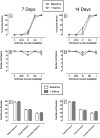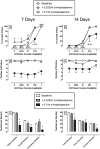Effects of 14-day treatment with the schedule III anorectic phendimetrazine on choice between cocaine and food in rhesus monkeys
- PMID: 23726979
- PMCID: PMC3713102
- DOI: 10.1016/j.drugalcdep.2013.05.005
Effects of 14-day treatment with the schedule III anorectic phendimetrazine on choice between cocaine and food in rhesus monkeys
Erratum in
- Drug Alcohol Depend. 2013 Dec 1;133(2):794
Abstract
Background: The clinical utility of monoamine releasers such as phenmetrazine or d-amphetamine as candidate agonist medications for cocaine dependence is hindered by their high abuse liability. Phendimetrazine is a clinically available schedule III anorectic that functions as a prodrug for phenmetrazine and thus may have lower abuse liability. This study determined the effects of continuous 14-day treatment with phendimetrazine on cocaine vs. food choice in rhesus monkeys (N=4).
Methods: Responding was maintained under a concurrent schedule of food delivery (1-g pellets, fixed-ratio 100 schedule) and cocaine injections (0-0.1mg/kg/injection, fixed-ratio 10 schedule). Cocaine choice dose-effect curves were determined daily before and during 14-day periods of continuous intravenous treatment with saline or (+)-phendimetrazine (0.32-1.0mg/kg/h). Effects of 14-day treatment with (+)-phenmetrazine (0.1-0.32 mg/kg/h; N=5) and d-amphetamine (0.032-0.1mg/kg/h; N=6) were also examined for comparison.
Results: During saline treatment, food was primarily chosen during availability of low cocaine doses (0, 0.0032, and 0.01 mg/kg/injection), and cocaine was primarily chosen during availability of higher cocaine doses (0.032 and 0.1mg/kg/injection). Phendimetrazine initially decreased overall responding without significantly altering cocaine choice. Over the course of 14 days, tolerance developed to rate decreasing effects, and phendimetrazine dose-dependently decreased cocaine choice (significant at 0.032 mg/kg/injection cocaine). Phenmetrazine and d-amphetamine produced qualitatively similar effects.
Conclusions: These results demonstrate that phendimetrazine can produce significant, though modest, reductions in cocaine choice in rhesus monkeys. Phendimetrazine may be especially suitable as a candidate medication for human studies because of its schedule III clinical availability.
Keywords: Amphetamine; Choice; Cocaine; Phendimetrazine; Phenmetrazine; Rhesus monkey.
Copyright © 2013 Elsevier Ireland Ltd. All rights reserved.
Conflict of interest statement
Figures




References
-
- Banks ML, Blough BE, Fennell TR, Snyder RW, Negus SS. Role of phenmetrazine as an active metabolite of phendimetrazine: evidence fromstudies of drug discrimination and pharmacokinetics in rhesus monkeys. Drug Alcohol Depend. 2012 epub 2012 Dec 1 http://dx.doi.org/10.1016/j.drugalcdep.2012.10.026. - DOI - PMC - PubMed
Publication types
MeSH terms
Substances
Grants and funding
LinkOut - more resources
Full Text Sources
Other Literature Sources

